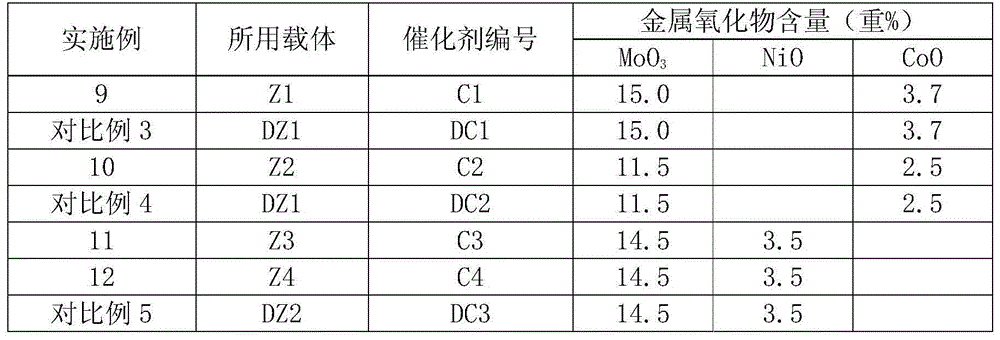Heavy-oil hydrotreatment catalyst, and preparation and application thereof
A heavy oil hydrogenation and catalyst technology, applied in the direction of physical/chemical process catalysts, catalyst carriers, metal/metal oxide/metal hydroxide catalysts, etc., can solve the problem that the removal rate of heavy metals and asphaltenes cannot be achieved Good matching, low removal rate and carbon residue removal rate, low catalyst desulfurization rate, etc.
- Summary
- Abstract
- Description
- Claims
- Application Information
AI Technical Summary
Problems solved by technology
Method used
Image
Examples
Embodiment 1
[0056] Weigh 1000 g of P1-1, then add 1440 ml of aqueous solution containing 10 ml of nitric acid (product of Tianjin Chemical Reagent No. Dry the wet strips at 120°C for 4 hours to obtain dry strips, shape the dry strips, sieve, grind and sieve the dry strip materials (generally called industrial dry strip waste) with a length of less than 2mm, and take 100-200 Mesh sieving to obtain the modified product P2A of P1-1. The k values of P2A are shown in Table 1.
Embodiment 2
[0058] Weigh 1000 g of P1-1, and flash dry at 240°C for 6 minutes to obtain P2B, a modified product of P1-1. See Table 1 for the k values of P2B.
Embodiment 3
[0060] Weigh 1000 grams of P1-2, add 1440 ml of aqueous solution containing 10 ml of nitric acid (product of Tianjin Chemical Reagent No. The wet strips were dried at 120°C for 4 hours, and roasted at 600°C for 4 hours to obtain the carrier. The carrier strips were shaped and sieved, and the carrier strip materials (generally called industrial carrier waste) with a length of less than 2mm were ground, sieved, and collected. Among them, 100-200 mesh sieve, namely the modified product P2C of P1-2. See Table 1 for the k value of P2C.
PUM
 Login to View More
Login to View More Abstract
Description
Claims
Application Information
 Login to View More
Login to View More - R&D
- Intellectual Property
- Life Sciences
- Materials
- Tech Scout
- Unparalleled Data Quality
- Higher Quality Content
- 60% Fewer Hallucinations
Browse by: Latest US Patents, China's latest patents, Technical Efficacy Thesaurus, Application Domain, Technology Topic, Popular Technical Reports.
© 2025 PatSnap. All rights reserved.Legal|Privacy policy|Modern Slavery Act Transparency Statement|Sitemap|About US| Contact US: help@patsnap.com



